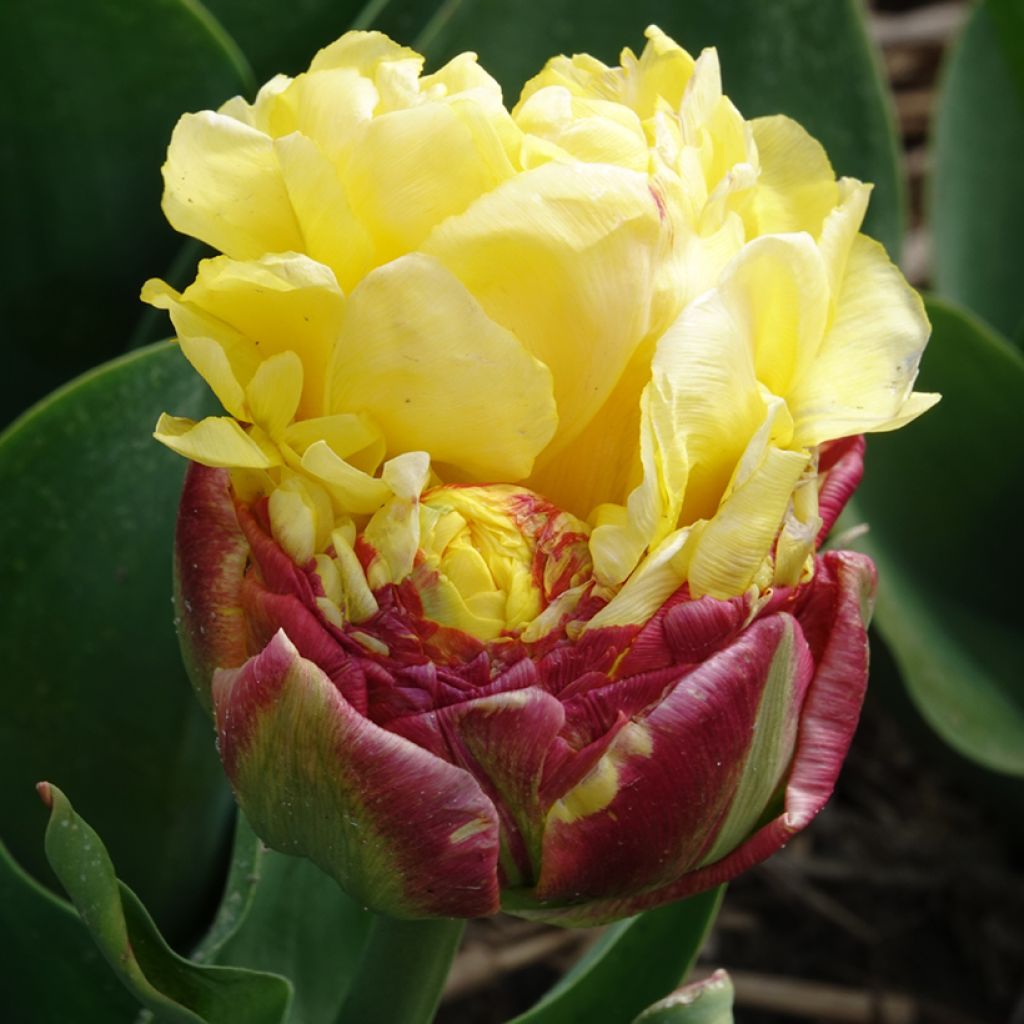

Tulipán doble de flor tardía Ice cream Banana


Tulipán doble de flor tardía Ice cream Banana
Tulipán doble de flor tardía Ice cream Banana
Tulipa Ice cream Banana
Tulipán doble de flor tardía
¡Oferta especial!
¡Recibe un vale de compra de 20 € por cualquier pedido superior a 90 € (sin incluir gastos de envío, abonos y opción sin plástico)!
1- Añade tus plantas favoritas a la cesta.
2- Una vez alcances los 90 €, confirma tu pedido (¡incluso puedes elegir la fecha de entrega!).
3- Tan pronto como se envíe tu pedido, recibirás un correo electrónico con el código de tu vale de compra, válido durante 3 meses (90 días).
Su vale es único y solo se puede utilizar una vez, para cualquier pedido de un importe mínimo de 20 €, sin incluir los gastos de envío.
Acumulable con otras ofertas en curso, no divisible y no reembolsable.
6 meses de garantía en el desarrollo de esta planta
Más información
Garantizamos la calidad de nuestras plantas durante un ciclo vegetativo completo, y sustituiremos a nuestro cargo cualquier planta que no se recupere en condiciones climáticas y de plantación normales.
¿Esta planta es adecuada para mi jardín?
Crear mi perfil Plantfit →
Descripción
El Tulipán Doble Tardío 'Ice Cream Banana' es tan atractivo como el helado más delicioso ! Esta variedad ofrece flores realmente originales, compuestas por un centro de pétalos amarillos bien apretados, rodeados por pétalos de un rojo violáceo mezclado con verde. El tallo es corto y sólido, lo que la convierte en un sujeto interesante en el jardín, en macetas y jardineras. Este tulipán se combina naturalmente con la variedad 'Ice Cream'.
El Tulipán 'Ice Cream Banana' pertenece a la familia de las Liliáceas. De origen hortícola, introducida en los Países Bajos en 2020, actualmente se clasifica en el grupo de los "Tulipanes dobles tardíos", cuya principal característica es presentar flores muy dobles y arrugadas, con formas de peonías. 'Ice Cream Banana' no es muy alta (35-40 cm) y su flor es de buen tamaño, doble y curiosamente dispuesta. Cuando se forma, la flor parece ser de color rosa oscuro, pero de repente aparece en su centro una corola alta llena de pétalos amarillos. La floración ocurre a mediados de mayo, al final de la temporada de tulipanes. Las flores duran mucho en jarrón o en el jardín. La follaje se seca poco después de la floración, mientras que el bulbo entra en reposo.
Colores variados, suaves o brillantes, flores opulentas y naíf, extravagantes o caprichosas, los tulipanes dobles tardíos insuflan un aire de fantasía en los jardines y en las terrazas soleadas. 'Ice Cream Banana' complacerá a los amantes del tulipán 'Exquisit', ambas parecen venir de otro mundo. Para realzarlas, plántalas en medio de pequeñas flores ligeras como la manzanilla o el nomeolvides blanco 'Snowsylva'. 'Ice Cream Banana' también lucirá muy bien sobre un tapiz de alquemilas.
No olvides considerar la altura y el período de floración al diseñar tus macizos de flores, ya que estos parámetros varían significativamente de un cultivar a otro. Es prudente plantar un poco más de bulbos para los ramos, ya que duran mucho en jarrón.
En cuanto a las especies botánicas: los tulipanes silvestres se encuentran desde Europa occidental hasta China y Japón pasando por Europa oriental, Asia Menor, Asia central. Su área de distribución también abarca el norte de África y el subcontinente indio. El centro de diversidad del género Tulipa se encuentra en las montañas del Pamir y el Hindú Kush, así como en las estepas de Kazajistán.
En Francia existen diversas especies silvestres, muchas de las cuales están amenazadas. Se trata ya sea de grandes tulipanes adventicios de los cultivos, siendo el más conocido el tulipán de Agen (Tulipa agenensis), o de pequeños tulipanes presentes en zonas boscosas o entre rocas en montañas. Uno de los más comunes es el tulipán silvestre (Tulipa sylvestris), que solía crecer a menudo al abrigo de las vides. Su subespecie australis es conocida como tulipán meridional.
Informar de un error en la descripción del producto
Porte
Floración
Follaje
Botánica
Tulipa
Ice cream Banana
Liliaceae
Tulipán doble de flor tardía
Tulipa Ice cream Banana
Hortícola
Plantación y cuidados
¿Cuándo plantar?
¿En qué lugar?
Cuidado
Este artículo todavía no ha recibido comentarios; sé el primero en compartir tu experiencia.
¿No has encontrado lo que buscas?
La rusticidad es la temperatura invernal más baja que una planta puede soportar sin sufrir daños graves o incluso la muerte. Sin embargo, la rusticidad se ve afectada por la ubicación (zona protegida, como un patio), la protección (cubierta de invierno) y el tipo de suelo (la rusticidad mejora con un suelo bien drenado).

Condiciones generales de uso del servicio de fotos del cliente
Con el fin de favorecer la interacción y el intercambio de experiencias entre jardineros, Promesse de fleurs ofrece varios servicios que permiten cargar contenidos en su Sitio web, en particular a través del módulo "Compartir fotos".
El usuario se compromete a no:
- Publicar contenidos ilegales, perjudiciales, insultantes, racistas, que inciten al odio, revisionistas, contrarios a las buenas costumbres, que atenten contra la vida privada o vulneren los derechos privados de terceros, en particular el derecho a la imagen de las personas y de los bienes, los derechos de propiedad intelectual o el derecho a la vida privada
- Publicar contenidos en nombre de un tercero
-
Asumir la identidad de un tercero y/o publicar cualquier información personal sobre un tercero
En general, los Usuarios se comprometen a abstenerse de cualquier comportamiento poco ético.
Todos los Contenidos, en particular, textos, comentarios, archivos, imágenes, fotos, vídeos, obras, etc., que pueden ser objeto de derechos de propiedad, derechos de propiedad intelectual, derechos de imagen u otros derechos privados, siguen siendo propiedad del Usuario, a reserva de los derechos limitados concedidos por la licencia definida a continuación a Promesse de fleurs. El Usuario es libre de publicar o no dicho Contenido en el Sitio web, especialmente a través del servicio "Compartir fotos", y acepta que este Contenido se haga público y libremente accesible, especialmente en Internet.
Reconocen, se comprometen y garantizan que disponen de todos los derechos y autorizaciones necesarios para dicha publicación en el Sitio, en particular en lo que respecta a la legislación vigente y a los derechos de privacidad, propiedad, propiedad intelectual, imagen, contratos o de cualquier otra naturaleza. Al publicar dicho Contenido en el Sitio, el Usuario es consciente de que compromete su responsabilidad como editor del Contenido en el sentido de la ley, y concede a Promesse de fleurs una licencia no exclusiva, gratuita y mundial para dicho Contenido, durante toda la duración de su publicación, incluidos los derechos de reproducción, representación, carga, visualización, ejecución, transmisión y almacenamiento.
Los usuarios también autorizan a que su nombre se asocie al Contenido y aceptan que esta asociación no siempre pueda realizarse.
Mediante su publicación, los usuarios autorizan que los Contenidos sean automáticamente accesibles en Internet, en particular en otros sitios y/o blogs y/o páginas web del sitio Promesse de fleurs, incluidas en particular las páginas de las redes sociales y el catálogo de Promesse de fleurs.
Los usuarios pueden obtener libremente la devolución de los contenidos confiados poniéndose en contacto con el servicio de atención al cliente a través del formulario de contacto.
Los periodos de siembra indicados en nuestro sitio web se aplican a los países y regiones de la zona 8 del USDA (Francia, Reino Unido, Irlanda, Países Bajos).
En zonas más frías (Escandinavia, Polonia, Austria...), retrase 3-4 semanas cualquier siembra al aire libre, o siembre en invernadero.
En climas más cálidos (Italia, España, Grecia, etc.), adelante unas semanas la siembra al aire libre.
El periodo de recolección indicado en nuestro sitio web se aplica a los países y regiones de la zona USDA 8 (Francia, Inglaterra, Irlanda, Países Bajos).
En las zonas más frías (Escandinavia, Polonia, Austria...) es probable que la cosecha de frutas y hortalizas se retrase 3-4 semanas.
En las zonas más cálidas (Italia, España, Grecia...), es probable que la cosecha se adelante, dependiendo de las condiciones meteorológicas.
El periodo de plantación indicado en nuestro sitio web se aplica a los países y regiones situados en la zona USDA 8 (Francia, Reino Unido, Irlanda, Países Bajos).
Variará en función de su lugar de residencia:
- En las zonas mediterráneas (Marsella, Madrid, Milán, etc.), el otoño y el invierno son los mejores periodos de plantación.
- En las zonas continentales (Estrasburgo, Múnich, Viena, etc.), retrase la plantación de 2 a 3 semanas en primavera y adelántela de 2 a 4 semanas en otoño.
- En las regiones montañosas (Alpes, Pirineos, Cárpatos, etc.), es mejor plantar a finales de primavera (mayo-junio) o a finales de verano (agosto-septiembre).
En climas templados, la poda de los arbustos de floración primaveral: forsitia, spireas, etc. debe realizarse justo después de la floración.
La poda de los arbustos de floración estival: árbol de Júpiter, perovskia, etc. puede realizarse en invierno o en primavera.
En las regiones frías y con plantas sensibles a las heladas, evite podar demasiado pronto, cuando aún pueden producirse heladas severas.
El periodo de floración indicado en nuestra página web se aplica a los países y regiones situados en la zona USDA 8 (Francia, Reino Unido, Irlanda, Países Bajos, etc.).
Variará en función de su lugar de residencia:
- En las zonas 9 a 10 (Italia, España, Grecia, etc.), la floración se producirá entre 2 y 4 semanas antes.
- En las zonas 6 a 7 (Alemania, Polonia, Eslovenia y regiones montañosas bajas), la floración se retrasará de 2 a 3 semanas.
- En la zona 5 (Europa Central, Escandinavia), la floración se retrasará de 3 a 5 semanas.
































